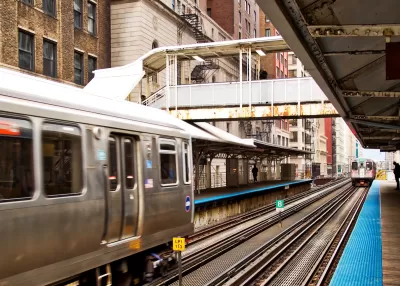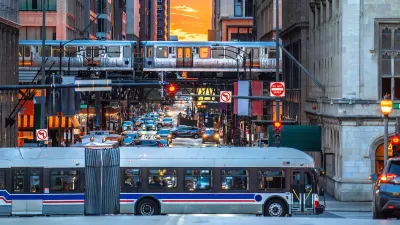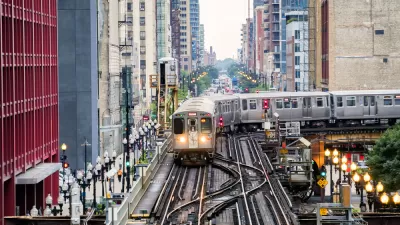A dire warning from regional transit leaders paints a bleak scenario for traffic if agencies are forced to cut service.

Officials from Chicago’s Regional Transportation Authority (RTA) are warning that traffic in the city’s North Side could “grind to a halt” as funding for transit runs out, reports David Struett in the Chicago Sun-Times.
If the state increases spending by 20 percent, the agencies could add 30 to 40 percent more trains and buses, according to a presentation from the RTA. “A bill working its way through the state Legislature seeks to do something like that. The Metropolitan Mobility Authority Act would pump $1.5 billion a year into the area’s public transit, though legislators first want reforms, such as potentially combining the Chicago area’s four agencies into one.”
Without additional state funding, the Chicago Transit Authority, Metra and Pace face a $730 million debt after 2026, forcing service cuts that could almost double travel times in some areas. If the agencies are forced to cut service, “The Chicago area could see a $2.6 billion loss in gross domestic product, largely driven by about 27,000 jobs that are lost in the first year.” A study from the U.S. Department of Energy’s Argonne National Laboratory and MIT found that service cuts could result in a loss of roughly $35 billion in economic activity annually.
The RTA wants state legislators to give it more control over the other three agencies, arguing that “The changes could bring more federal money to Chicago-area transit projects, since federal grants increasingly want to see ‘regional vision and coordination in projects.’” The agencies largely oppose a proposal to consolidate them into one regional agency.
FULL STORY: Traffic may 'grind to a halt' after transit COVID-19 grants run out, RTA warns

Study: Maui’s Plan to Convert Vacation Rentals to Long-Term Housing Could Cause Nearly $1 Billion Economic Loss
The plan would reduce visitor accommodation by 25,% resulting in 1,900 jobs lost.

North Texas Transit Leaders Tout Benefits of TOD for Growing Region
At a summit focused on transit-oriented development, policymakers discussed how North Texas’ expanded light rail system can serve as a tool for economic growth.

Using Old Oil and Gas Wells for Green Energy Storage
Penn State researchers have found that repurposing abandoned oil and gas wells for geothermal-assisted compressed-air energy storage can boost efficiency, reduce environmental risks, and support clean energy and job transitions.

Santa Barbara Could Build Housing on County Land
County supervisors moved forward a proposal to build workforce housing on two county-owned parcels.

San Mateo Formally Opposes Freeway Project
The city council will send a letter to Caltrans urging the agency to reconsider a plan to expand the 101 through the city of San Mateo.

A Bronx Community Fights to Have its Voice Heard
After organizing and giving input for decades, the community around the Kingsbridge Armory might actually see it redeveloped — and they want to continue to have a say in how it goes.
Urban Design for Planners 1: Software Tools
This six-course series explores essential urban design concepts using open source software and equips planners with the tools they need to participate fully in the urban design process.
Planning for Universal Design
Learn the tools for implementing Universal Design in planning regulations.
Borough of Carlisle
Caltrans
Heyer Gruel & Associates PA
Institute for Housing and Urban Development Studies (IHS)
City of Grandview
Harvard GSD Executive Education
Toledo-Lucas County Plan Commissions
Salt Lake City
NYU Wagner Graduate School of Public Service





























